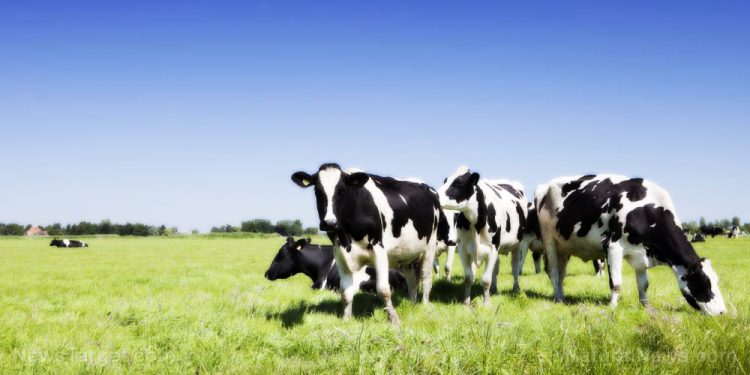(Natural News)—A war against farmers is happening in Europe and it is now starting to happen in America.
Small farmers are under attack in the state of Oregon, which has started shutting down family farms throughout the Beaver State under the pretense of water conservation and groundwater protection. (Related: ENGINEERED FAMINE: Oregon starts SHUTTING DOWN small farms “to protect the people.”)
The owner of Yanasa Ama Ranch shared a 20-minute video from Yanasa TV explaining what is happening in Oregon as bureaucrats mistakenly classify small family farms and homesteads as “concentrated animal feeding operations,” or CAFOs, to shut them down “for the environment.”
Any feeding area that has a concrete, rock or gravel floor falls into this classification, which could include small dairy or egg farms.
The rancher added that if a farmer has two or three milking cows, they are now targeted by the state for closure.
“The state of Oregon has effectively shut down small farms and market gardens on a large scale, and they’re actually sending out cease-and-desist letters to farms and they’re using satellite technology to find their victims and send them these letters that say you can’t operate,” the rancher explained in the video.
The rancher stated that there are two different laws that Oregon officials are using to carry out these shutdowns. And one of the laws includes Oregon’s widely unclear definition of a CAFO, which reads, in part, as follows:
“The State of Oregon defines CAFOs as the concentrated feeding or holding of animals or poultry, including but not limited to horse, cattle, sheep, or swine feeding areas, dairy confinement areas, and poultry and egg production facilities where the surface has been prepared with concrete, rock or fibrous material to support animals in wet weather.”
According to this definition, a few-acre homestead with pasture and let’s say two milking cows and some chickens qualifies as a CAFO if it has any area on the property where rock or gravel is used as a route to get to a small barn or coop.
“The way that they have redefined CAFOs is going to impact nearly everybody. Even on our property, we don’t have animals that are necessarily contained in one area (they’re roaming on pastures),” the rancher warned about Oregon’s “updated” CAFO definition.
Small family farms throughout Oregon have filed a lawsuit against the state’s updated CAFO law
A lawsuit was filed in January this year on behalf of small family farms throughout Oregon, claiming that the definition of a CAFO is too wide and negatively affects almost anybody who produces eggs from backyard chickens, no matter the size of their property.
According to the National Review, Oregon’s government “joined forces” with the massive dairy industry to crush and suppress Oregon’s small farmers.
“This law is being enforced in the state of Oregon,” the rancher said, sharing the same story as National Review about Godspeed Hollow Farm in Newburg, Oregon, which has been recategorized as a CAFO for the simple reason that it has a gravel pathway from the milking machine to the pickup station just 100 feet in distance.
“[Oregon] has already shut down some farms. There is an injunction on some of the definitions of the law until it can be heard in court. Currently, small dairy farmers … a lot of what they’re requiring is simply too much for the small farmer.”
Another issue that Oregon farmers have to contend with is the state’s rules on water.
The only water that farmers are legally permitted to collect in Oregon is rainwater while all other things, including water from rivers and streams, in addition to groundwater on private property, are deemed a public resource.
Due to this rule, Oregon farmers are not even permitted to utilize water from their private wells to water their crops and hydrate their animals without a permit.
Together with the CAFO rule, this one concerning water use is being abused in this manner as to make it restrictive, if not impossible, for farmers to manage their farms.
“This rule went into place back in 2021,” the rancher stated about how Oregon officials passed the water rule, which just so happens to have occurred at a period when everybody was being troubled and shocked by Wuhan coronavirus (COVID-19) “pandemic” tyranny.
“It has slowly rolled out to the point where market gardeners on a half-acre of land are now receiving cease-and-desist orders saying, ‘you can’t water your gardens; figure out another way,'” the rancher added.
The apparent goal of this is to centralize power and control over the food market into the hands of a moneyed elite while denying small farmers their livelihoods and incomes in addition to their God-given right to grow, produce, consume and sell the fruit of their work.
If this sort of thing can occur in Oregon, it can happen everywhere in America.
Follow FoodFreedom.news for more stories about the food war going on against farmers. Watch Dr. Jordan Peterson explain why governments are attacking farmers.
&
This video is from the GalacticStorm channel on Brighteon.com.
More related stories:
- The globalist plan to eliminate all farms: No more food, no more humans.
- Green cult destroying farmland to reduce population – that’s what going “carbon zero” actually means.
- Researcher Sandi Adams: The so-called “food transition” is just a war on farmers to control the global food supply.
Sources include:




